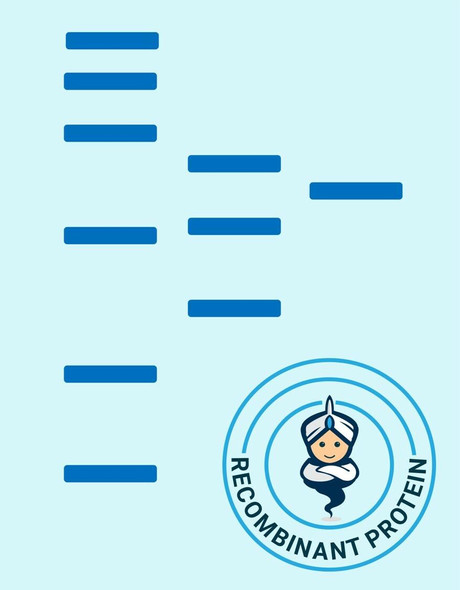Description
| Product Name: | Human LITAF Recombinant Protein |
| Product Code: | RPPB3867 |
| Size: | 20µg |
| Species: | Human |
| Target: | LITAF |
| Synonyms: | Lipopolysaccharide-induced TNF-alpha factor, PIG7, SIMPLE, Lipopolysaccharide-induced tumor necrosis factor-alpha factor, LPS-induced TNF-alpha factor, p53-induced gene 7 protein, Small integral membrane protein of lysosome/late endosome, LITAF. |
| Source: | Escherichia Coli |
| Physical Appearance: | Sterile Filtered colorless solution. |
| Formulation: | The LITAF solution (1mg/ml) contains 20mM Tris-HCl buffer (pH 8.0), 0.4M Urea and 10% glycerol. |
| Stability: | Store at 4°C if entire vial will be used within 2-4 weeks. Store, frozen at -20°C for longer periods of time. For long term storage it is recommended to add a carrier protein (0.1% HSA or BSA).Avoid multiple freeze-thaw cycles. |
| Purity: | Greater than 85% as determined by SDS-PAGE. |
| Amino Acid Sequence: | MGSSHHHHHH SSGLVPRGSH MSVPGPYQAA TGPSSAPSAP PSYEETVAVN SYYPTPPAPM PGPTTGLVTG PDGKGMNPPS YYTQPAPIPN NNPITVQTVY VQHPITFLDR PIQMCCPSCN KMIVSQLSYN AGALTWLSCG SLCLLGCIAG CCFIPFCVDA LQDVDHYCPN CRALLGTYKR L |
Lipopolysaccharide-induced TNF-alpha factor (LITAF) is a small integral membrane protein of lysosome/late endosome. The expression of inflammatory cytokines such as TNF-alpha in Lipopolysaccharide-induced processes is mediated by LITAF. LITAF connects to STAT6B, which belongs to the STAT6 family forming a complex on the TNF-alpha promoter that modifies TNF activity. High levels of expression of LITAF mRNA are observed mostly in the placenta, peripheral blood leukocytes, lymph nodes and spleen.
LITAF Human Recombinant produced in E.coli is a single, non-glycosylated polypeptide chain containing 181 amino acids (1-161) and having a molecular mass of 19.2 kDa. LITAF is fused to a 20 amino acid His-tag at N-terminus & purified by proprietary chromatographic techniques.
| UniProt Protein Function: | LITAF: Probable role in regulating transcription of specific genes. May regulate through NFKB1 the expression of the CCL2/MCP-1 chemokine. May play a role in tumor necrosis factor alpha (TNF- alpha) gene expression. Interacts with NEDD4. Interacts with WWOX. Isoform 2 may interact with STAT6. By bacterial lipopolysaccharides (LPS) or p53/TP53. In monocytes by the Bacillus Calmette-Guerin (BCG). Ubiquitously and abundantly expressed. Expressed predominantly in the placenta, peripheral blood leukocytes, lymph nodes and spleen. 2 isoforms of the human protein are produced by alternative splicing. |
| UniProt Protein Details: | Protein type:Transcription factor; Oncoprotein Chromosomal Location of Human Ortholog: 16p13.13 Cellular Component: nucleoplasm; Golgi apparatus; intracellular membrane-bound organelle; lysosomal membrane; cytoplasm; plasma membrane Molecular Function:signal transducer activity; protein binding; WW domain binding Biological Process: regulation of transcription from RNA polymerase II promoter; positive regulation of I-kappaB kinase/NF-kappaB cascade; transcription, DNA-dependent; apoptosis; negative regulation of NF-kappaB import into nucleus; signal transduction; regulation of cytokine production; aging Disease: Charcot-marie-tooth Disease, Demyelinating, Type 1c |
| NCBI Summary: | Lipopolysaccharide is a potent stimulator of monocytes and macrophages, causing secretion of tumor necrosis factor-alpha (TNF-alpha) and other inflammatory mediators. This gene encodes lipopolysaccharide-induced TNF-alpha factor, which is a DNA-binding protein and can mediate the TNF-alpha expression by direct binding to the promoter region of the TNF-alpha gene. The transcription of this gene is induced by tumor suppressor p53 and has been implicated in the p53-induced apoptotic pathway. Mutations in this gene cause Charcot-Marie-Tooth disease type 1C (CMT1C) and may be involved in the carcinogenesis of extramammary Paget's disease (EMPD). Multiple alternatively spliced transcript variants have been found for this gene. [provided by RefSeq, Dec 2014] |
| UniProt Code: | Q99732 |
| NCBI GenInfo Identifier: | 83304387 |
| NCBI Gene ID: | 9516 |
| NCBI Accession: | Q99732.2 |
| UniProt Secondary Accession: | Q99732,Q05DW0, Q9C0L6, D3DUG1, G5E9K0, |
| UniProt Related Accession: | Q99732 |
| Molecular Weight: | 161 |
| NCBI Full Name: | Lipopolysaccharide-induced tumor necrosis factor-alpha factor |
| NCBI Synonym Full Names: | lipopolysaccharide-induced TNF factor |
| NCBI Official Symbol: | LITAF�� |
| NCBI Official Synonym Symbols: | PIG7; SIMPLE; TP53I7�� |
| NCBI Protein Information: | lipopolysaccharide-induced tumor necrosis factor-alpha factor; p53-induced gene 7 protein; LPS-induced TNF-alpha factor; tumor protein p53 inducible protein 7; lipopolysaccharide-induced TNF-alpha factor; small integral membrane protein of lysosome/late endosome |
| UniProt Protein Name: | Lipopolysaccharide-induced tumor necrosis factor-alpha factor |
| UniProt Synonym Protein Names: | Small integral membrane protein of lysosome/late endosome; p53-induced gene 7 protein |
| Protein Family: | Lipopolysaccharide-induced tumor necrosis factor-alpha factor |
| UniProt Gene Name: | LITAF�� |
| UniProt Entry Name: | LITAF_HUMAN |






